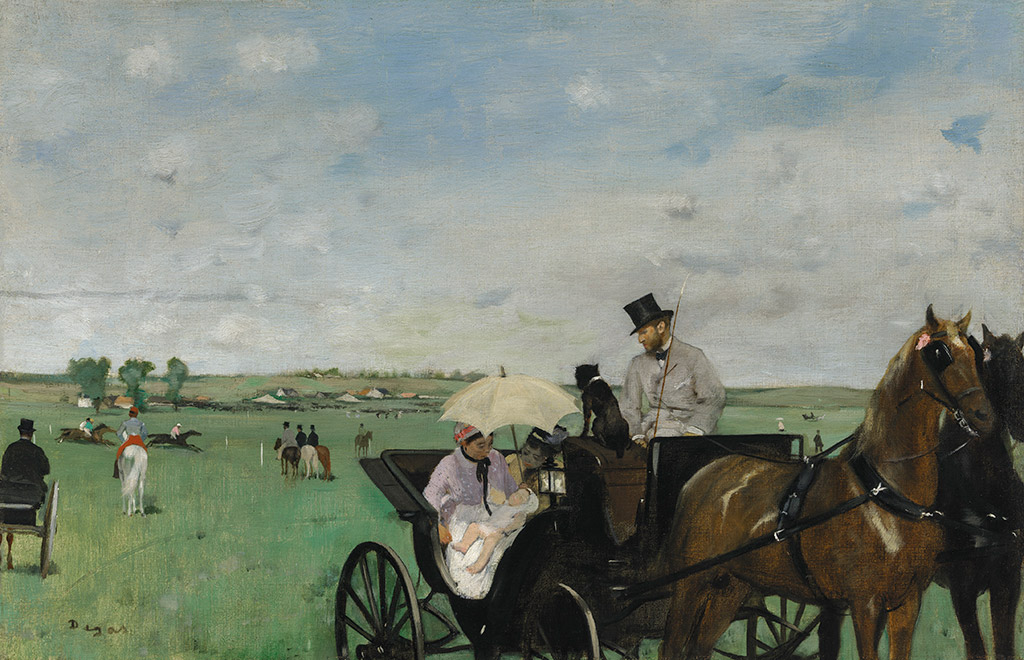Impressionism, one of the most influential art movements of the 19th century, began as a radical departure from the academic conventions that had dominated European art for centuries. Its origins can be traced to Paris in the late 1860s, where a group of young artists—frustrated by the rigid rules and rejection from prestigious art institutions—sought new ways to depict the world around them. This revolutionary spirit culminated in the first independent Impressionist exhibition in 1874, which not only introduced the public to a daring, unconventional style but also set the stage for the emergence of modern painting.
The seeds of Impressionism were sown in an era of great social, political, and industrial change. France, particularly Paris, had undergone rapid modernization. The expansion of railways, the development of leisure activities like café culture, horse racing, and the opera, and the rebuilding of Paris under Baron Haussmann all transformed the urban landscape. Artists such as Edgar Degas, Claude Monet, Pierre-Auguste Renoir, and Camille Pissarro found themselves captivated by these modern experiences, which they felt were inadequately captured by the historical and mythological themes that dominated academic painting.
Traditionally, the Paris Salon—an official art exhibition organized by the French government—was the most prestigious platform for artists to display their work. However, the Salon had stringent standards, favoring highly polished, realistic depictions of historical or mythological subjects. For artists like Degas and Monet, whose interest lay in the contemporary world and who experimented with looser brushwork, the Salon’s gatekeeping presented a barrier. Faced with repeated rejection, a group of artists decided to form their own collective and organize an exhibition outside the control of the Salon.
In 1874, this group held their first exhibition in a photography studio owned by Félix Nadar, located on the Boulevard des Capucines in Paris. This exhibition, now recognized as the birth of Impressionism, featured works by artists who would later become giants of the movement. Among them was Edgar Degas, whose “At the Races in the Countryside (Les courses)” (1869), showcased the experimental approach to composition, color, and perspective that defined Impressionist art.
Degas’ painting captures a scene at a horse race, a popular subject for Impressionists because it represented the leisure activities of modern life. Rather than focusing solely on the horses, Degas places emphasis on the spectators and the atmosphere, using a slightly skewed perspective and unusual cropping to create a sense of immediacy and movement. His brushstrokes are visible and expressive, a hallmark of the Impressionist technique, and he employs a bright, naturalistic color palette that contrasts sharply with the darker, more somber tones favored by academic artists. This focus on capturing the fleeting moments of everyday life, rather than idealized historical narratives, was a defining feature of Impressionism.
The term “Impressionism” itself originated from this first exhibition, specifically from a satirical review by the critic Louis Leroy. Writing for the newspaper “Le Charivari”, Leroy poked fun at the painting “Impression, Sunrise” by Claude Monet, describing it as nothing more than a mere “impression” rather than a fully realized work of art. Leroy’s intention was to mock the group’s unfinished, sketch-like style, but the artists embraced the term, and “Impressionism” soon became the label for their movement.
Impressionism’s break with tradition was not limited to its subject matter or technique; it also represented a new philosophy of art. The movement was deeply influenced by advances in science and technology, particularly the study of light and color. In the 19th century, scientists like Michel Eugène Chevreul and Ogden Rood explored the optical effects of color, theorizing how complementary colors could enhance one another when placed side by side. The Impressionists incorporated these ideas into their work, often using bright, contrasting colors to create vibrant, luminous scenes.
Additionally, the invention of portable paint tubes allowed artists to leave their studios and paint en plein air (outdoors), a practice that became central to the Impressionist movement. Artists like Monet and Pissarro would set up their easels in fields, gardens, and on riverbanks, capturing the changing effects of sunlight and weather with rapid, spontaneous brushstrokes. This method resulted in paintings that felt fresh, immediate, and dynamic—qualities that stood in stark contrast to the meticulously detailed canvases of academic painters.
Degas, while associated with the Impressionists, was somewhat of an outlier in that he preferred to work indoors, often using photographs and sketches as reference. However, his interest in capturing modern life and his innovative use of composition aligned him with the movement’s core principles. “At the Races in the Countryside”, for example, demonstrates his fascination with unusual perspectives, as the horses and carriages in the background appear almost incidental, while the figures in the foreground seem to have been captured in a fleeting moment of conversation and observation.
While the first Impressionist exhibition introduced a new artistic language to the public, it was not without controversy. Critics were divided, with some praising the group’s innovative approach and others dismissing their work as unfinished, childish, or even anarchistic. The loose brushwork, emphasis on light, and unconventional compositions were seen by traditionalists as an affront to the established standards of beauty and craftsmanship. However, over time, Impressionism gained momentum, with subsequent exhibitions in 1876, 1877, and 1879, each further solidifying the movement’s place in art history.
The radical nature of the 1874 exhibition cannot be overstated. It marked the first time a group of artists had rejected the Salon system so completely, choosing instead to create their own platform for artistic expression. This act of defiance paved the way for future generations of modern artists, who would continue to push the boundaries of what art could be. In this sense, the birth of Impressionism was not just the introduction of a new style; it was the beginning of a new era in which art was liberated from the constraints of academic tradition.
The legacy of Impressionism is evident in the way it transformed both the practice and reception of art. The movement’s focus on the sensory experience of the world, its embrace of modern subjects, and its experimental techniques inspired countless artists in the late 19th and early 20th centuries, including the Post-Impressionists, the Fauves, and the Cubists. Artists like Vincent van Gogh, Paul Cézanne, and Henri Matisse built upon the foundations laid by Degas, Monet, and Renoir, pushing the boundaries of color, form, and abstraction even further.
Today, works like Degas’ “At the Races in the Countryside” are celebrated not only for their technical innovation but also for their ability to capture the essence of a fleeting moment—an impression of modern life, suspended in time. The Impressionists’ bold departure from tradition continues to resonate, reminding us that art, like life, is ever-changing, and that true creativity often lies in embracing the present moment, however fleeting it may be. The exhibition “Paris 1874: The Impressionist Moment” at the National Gallery of Art offers a fresh look at this revolutionary period, reminding us of the transformative power of artistic vision and the enduring impact of Impressionism on the world of art.
No comments yet.








